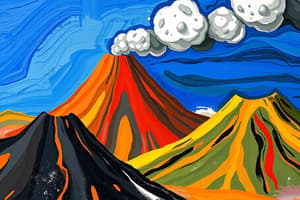Podcast
Questions and Answers
What is a volcano?
What is a volcano?
- A natural opening where molten rocks, smoke, gases, and ashes are ejected (correct)
- A human-made opening in the ground for scientific research
- A type of earthquake that causes the ground to shake
- A man-made structure to control volcanic eruptions
Which type of volcano is known for its perfect cone shape?
Which type of volcano is known for its perfect cone shape?
- Composite volcano (correct)
- Caldera volcano
- Shield volcano
- Cinder cone volcano
What is the name given to hot fluid material beneath Earth's crust?
What is the name given to hot fluid material beneath Earth's crust?
- Crater
- Magma (correct)
- Lava
- Ash
What triggers a caldera collapse in a volcano?
What triggers a caldera collapse in a volcano?
Which type of volcanic eruption involves violent explosions due to interactions between water and magma?
Which type of volcanic eruption involves violent explosions due to interactions between water and magma?
What causes variations in the types of volcanoes based on plate boundaries?
What causes variations in the types of volcanoes based on plate boundaries?
Flashcards
Volcano definition
Volcano definition
A natural opening where molten rock, smoke, gases, and ash are released.
Composite Volcano shape
Composite Volcano shape
A type of volcano with a steep, cone-like shape.
Magma definition
Magma definition
Molten rock beneath Earth's surface.
Caldera collapse trigger
Caldera collapse trigger
Signup and view all the flashcards
Water-magma eruption type
Water-magma eruption type
Signup and view all the flashcards
Volcano type variations cause
Volcano type variations cause
Signup and view all the flashcards
Study Notes
- Grade 9 science class is now in quarter 3, focusing on earth science and specifically different types of volcanoes.
- A volcano is a natural opening where molten rocks, smoke, gases, and ashes are ejected, with examples like Mayon Volcano in the Philippines known for its perfect cone.
- Volcanoes have three main parts: the base, slope, and summit where the crater is located; some volcanoes like the one in Batangas, Philippines, have numerous craters due to collapses after explosive eruptions.
- Caldera collapse occurs when a part of the crater wall collapses following a volcanic eruption triggered by the emptying of the magma chamber beneath the volcano.
- Magma is hot fluid material beneath Earth's crust, which when ejected out of a volcano is called lava, an Italian word meaning to slide.
- Types of volcanoes include shield volcanoes like Mauna Loa in Hawaii, cinder cone volcanoes like Mount Paricutin in Mexico, and composite volcanoes like Mayon Volcano in the Philippines.
- Volcanoes have different types due to variations in the process of magma formation at each type of plate boundary, leading to varying magma composition.
- Volcanic eruptions can be classified as phreatic, phreatomagmatic, strombolian, vulcanian, and plinian based on their characteristics and interactions between water and magma.
Studying That Suits You
Use AI to generate personalized quizzes and flashcards to suit your learning preferences.




